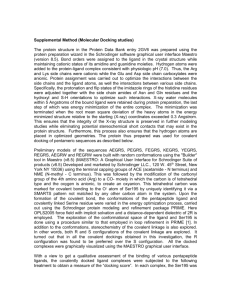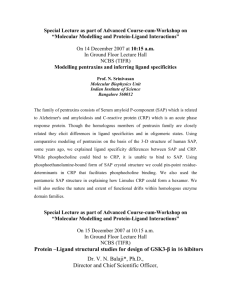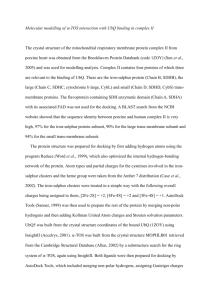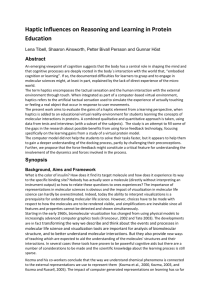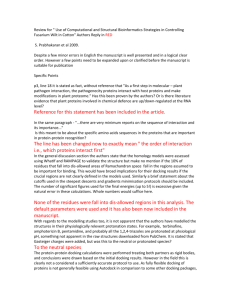472-137
advertisement
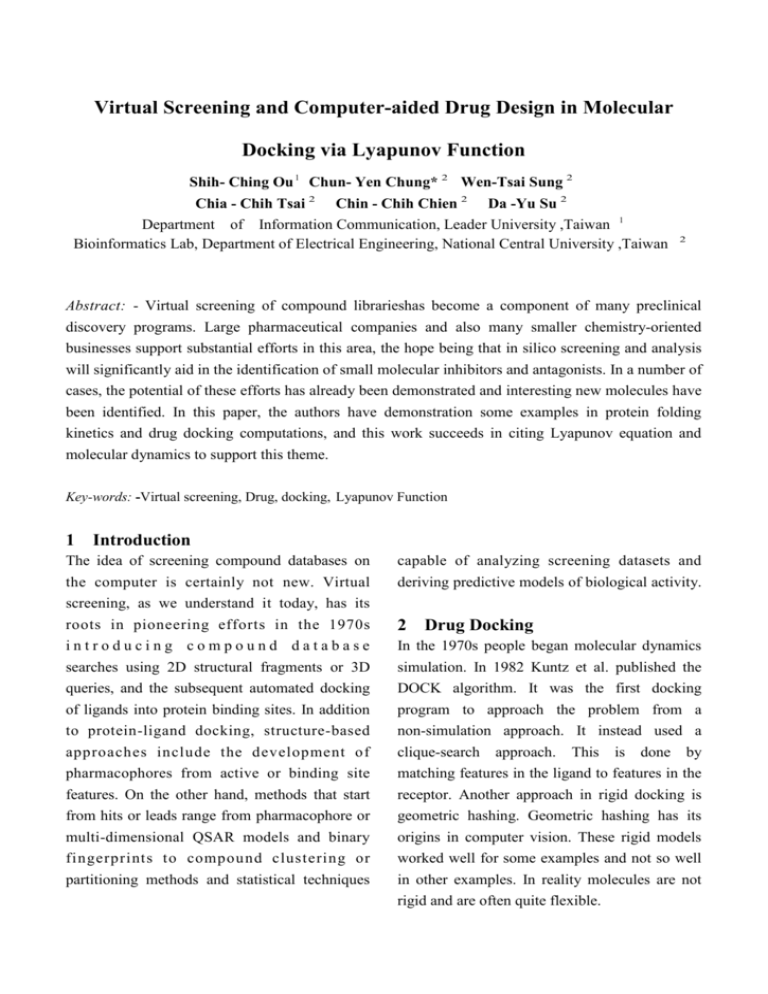
Virtual Screening and Computer-aided Drug Design in Molecular Docking via Lyapunov Function Shih- Ching Ou 1 Chun- Yen Chung* 2 Wen-Tsai Sung 2 Chia - Chih Tsai 2 Chin - Chih Chien 2 Da -Yu Su 2 Department of Information Communication, Leader University ,Taiwan 1 Bioinformatics Lab, Department of Electrical Engineering, National Central University ,Taiwan 2 Abstract: - Virtual screening of compound librarieshas become a component of many preclinical discovery programs. Large pharmaceutical companies and also many smaller chemistry-oriented businesses support substantial efforts in this area, the hope being that in silico screening and analysis will significantly aid in the identification of small molecular inhibitors and antagonists. In a number of cases, the potential of these efforts has already been demonstrated and interesting new molecules have been identified. In this paper, the authors have demonstration some examples in protein folding kinetics and drug docking computations, and this work succeeds in citing Lyapunov equation and molecular dynamics to support this theme. Key-words: -Virtual screening, Drug, docking, Lyapunov Function 1 Introduction The idea of screening compound databases on the computer is certainly not new. Virtual screening, as we understand it today, has its roots in pioneering efforts in the 1970s introducing compound database searches using 2D structural fragments or 3D queries, and the subsequent automated docking of ligands into protein binding sites. In addition to protein-ligand docking, structure-based capable of analyzing screening datasets and deriving predictive models of biological activity. approaches include the development of pharmacophores from active or binding site features. On the other hand, methods that start from hits or leads range from pharmacophore or multi-dimensional QSAR models and binary fingerprints to compound clustering or partitioning methods and statistical techniques clique-search approach. This is done by matching features in the ligand to features in the receptor. Another approach in rigid docking is geometric hashing. Geometric hashing has its origins in computer vision. These rigid models worked well for some examples and not so well in other examples. In reality molecules are not rigid and are often quite flexible. 2 Drug Docking In the 1970s people began molecular dynamics simulation. In 1982 Kuntz et al. published the DOCK algorithm. It was the first docking program to approach the problem from a non-simulation approach. It instead used a orientation of the previous pieces. FlexX is one of the more popular incremental approach programs. A third approach in flexible ligand docking is genetic algorithms and evolutionary programming. This approach mimics biological evolution, where the individuals are different configurations of the molecules. A fitness function determines whether or not different configurations are used in the next generation of configurations. One of the first programs developed using this approach was GOLD based Fig.1 : Hypothetical ligand and receptor molecules in undocked ( upper ) and docked ( lower ) configurations. Both on the ideas of Jones et al. There are various other techniques for flexible docking. A program that we used was AutoDock, which uses geometry and forces determine whether and how molecules will dock. In the docked image, hydrophobic areas, interacting through van der Waals forces, as well as oppositely charged areas, interacting electrostatically, come together. simulated annealing to find the docked conformation. Later a genetic algorithm approach was added to AutoDock. There is other less used approaches and approaches that combine the previously mentioned to round out the work done on flexible-ligand docking. Many good results have come from introducing ligand The ligand was the first part to become flexible. The ligand is usually a small molecule with few degrees of freedom. The first approach was to find all or most of the conformations the flexible ligand would take on and feed those conformations into a rigid docking program. The Flexibase/FLOG docking programs were based on this conformation ensemble approach. Another popular approach is fragmentation. In flexibility. However, the problem becomes much more difficult when trying to add in protein flexibility. A ligand is usually a small molecule with from 10 to 100 atoms. However, a protein has thousands of atoms, and thus has many more degrees of freedom. This makes the problem difficult, and solving this problem is what we've been working on. Our approach uses various search and dimensionality reduction techniques this case the ligand is broken up in some way and then placed piece by piece into the receptor. There are two major subsets of this approach. One is “place and join” where all of the fragments are placed independently and then the program tries to connect them together. The other is an incremental approach, where the fragments are placed one by one according to the to solve the problem. 3 Virtual libraries What are the sources of compounds for in silico screening? Two types of collection are generally used: ‘truly’ virtual libraries, produced by computational design; and libraries assembled from commercial sources or company important method and tool in the field of inventories. True virtual libraries are generally designed to populate theoretical ‘chemistry spaces ’, and can contain billions of molecules. The basic idea behind these predictions is of course not to synthesize all compounds (as in combinatorial library design, for example) but to select only preferred molecules. Other libraries focus on compounds that already exist. It is possible to extract several million compounds from catalogs of combinatorial or medicinal innovative drug research and development. CADD come into the circulation of innovative drug research could shorten the cycle and cost of research and development and enhance the success rate of screening. The great majority company adopts variety methods, including parallel protein simulation method, structurebased parallel docking program, drug-like prediction methods and QSAR analysis methods, to carry out the CADD. Therefore, we proposed chemistry vendors and organize these in a virtual library. In most pharmaceutical companies, computational groups also generate such some VHTS concepts and solution for this study via survey interrelated literatures. compound collections when developing acquisition strategies. Experience has shown that up to half of the collected compounds are not available for purchase for one reason or another, but the information content of these libraries is valuable. Unavailable molecules can usually be resynthesized, which is not the case in some truly virtual libraries, where the synthetic feasibility is frequently questioned by chemists. 4 Lead Discovery on CADD and VHTS The process of innovative drug discovery and development is time-consuming and expensive, while the rate for success is low. Generally, only one of 10,000 compounds synthesized by Fig.2 : Integration of high-throughput and virtual screening. After a library subset has been screened experimentally and a few initial hits have been chemist can reach the market. According to recent survey on current drugs on the market, on average it costs the pharmaceutical industry 300-500 million US dollars to bring a new chemical entity molecule to the marketplace, and the process from discovery to market usually takes 10-15 years. According to the overhead mentions, CADD has become a new and obtained, HTS data can be used to calculate predictive models of activity. These models are subsets for testing. The higher the information content the more successful data mining will be Smart. HTS screening will then have a greater value to the company. Fig.3 : The similarity paradox. A fingerprint search for damnacanthal, a potent inhibitor of tyrosine kinase p561ck, minor modifications (red) of this scaffold render compounds either active or inactive. In virtual screening calculatioms, both of these closely related analogs are considered similar to the template. 5 Inside Rational Drug Design Rational drug design (RDD) methods accelerate the discovery process for pharmaceutical research organizations. RDD involves the design and optimization of small, organic therapeutics from the ideal case, where a protein structure is available, to the other extreme where only a small collection of 'hits' from high throughput screening can be utilized. The breadth of innovative techniques for structure-based, analog, and combinatorial library design allows you to efficiently use information from all possible sources on your therapeutic target. 4 situations can arise in rational drug design: Fig. 4 : Four Situations for Drug Discovery 6 Molecular Mechanics and Dynamics (MM and MD) The mechanical molecular model was developed out of a need to describe molecular structures and properties in as practical a manner as possible. The range of applicability of molecular mechanics (MM) includes: Molecules containing thousands of atoms Organics, oligonucleotides, peptides, and saccharides Vacuum, implicit, or explicit solvent environments. Ground state only Therm od ynam i c and ki net i c properti es The object of MM is to predict the energy associated with a given conformation of a molecule. However, MM energies have no meaning as absolute quantities. Only differences in energy between two or more conformations have meaning. A simple MM energy equation is given by: Energy (E) = E Stretch + EBending + ETorsion + E Non-bonded Interactions (1) These equations together with the data (parameters) required to describe the behavior of different kinds of atoms and bonds, is called a force-field. Many different kinds of force-fields have been developed over the years. Some include additional energy terms that describe other kinds of deformations. Some force-fields account for coupling between bending and stretching in adjacent bonds in order to improve the accuracy of the mechanical model. All of the potential energy functions are illustrated in the graph below: Fig.6: Energy Lyapunov Functions Molecular Dynamic System for 8 Conclusion Fig.5 :potential energy function 7 Energy Lyapunov Functions for Molecular Dynamic System A Lyapunov functi on is som e kind of mathematical quantity that is maximized by a particular dynamical system as it changes according to whatever rules it works by. A general methodology in the stability analysis of equilibrium of a nonlinear dynamical system is to find a suitable Lyapunov function. This is in general a very difficult task, but for nonlinear molecular dynamic systems there often is a natural candidate Lyapunov fun ct i on, nam el y t h e ene r g y fun ct i on. Lyapunov developed a general theory of dynamic stability applicable to both linear and nonlinear systems. On the most elementary level, bu ilding a 3D representation of a small molecule that can be easily rotated and conformationally analyzed enables a thought process almost impossible to achieve from a 2D drawing. DRUG was founded to demonstrate that high performance computing computer assisted drug design not only dramatically improves the process of discovering new drugs, but also is an affordable tool for CADD industries. This study proposed a novel minimum energy scheme for drug docking applications. The proposed scheme preserves the important advantages inherent in a protein folding process and ligand become locked key. In final, authors cited Lyapunov Equation to prove the stability of drug docking. References: [1] M. Rarey, S. Wefing & T. Lengauer, "Placement of medium sized molecular fragmets into the active site of proteins", J. Comput.-Aided Mol. Design 10, 41-54, (1996). [2] P.J. Goodford, "A computational procedure for determinimg energetically favorable binding sites on biologically important macromolecules", J. Med. Chem. 28, 849-85, (1985). [3] T. Lengauer & M. Rarey, "Computational methods for biomolecular docking", Curr. [12] Osterberg, F., Morris, G.M., Sanner, M.F., Opin. Struct. Biol. 6, 402-406, (1996). [4] I.D. Kuntz, J.M. Blaney, S.J. Oatley, R.L. Langridge & T.E. Ferrin, "A geometric approach to macromolecule-ligand interactions", J. Mol. Biol. 161, 269-288, (1982). [5] http://www.cmpharm.ucsf.edu/kuntz/ dock.html [6] A.R. Leach & I.D. Kuntz, "Conformational analysis of flexible ligands in Olson, A.J., Goodsell, D.S. (2001) Proteins: Struct., Function, Ge netics 46:34-40. [13] Wen-Tsai Sung,Shih-Ching Ou,” Minimum Energy for Protein Folding Structure via Lyapunov Equation Molecular Dynamics” Symposium and Workshop of Bioinformatics in Taiwan 2003,Taipei,Tawan.5-7 Sept.2003. [14] Shih-Ching Ou,Wen-Tsai Sung,” Molecular Docking for Drug Design” Symposium and macromolecular receptor sites", J. Comp. Chem. 13, 730-748, (1992). [7] B.K. Shoichet, D.L. Bodian & I.D. Kuntz, Workshop of Bioinformatics in Taiwan 2003,Taipei,Taiwan. 5-7, Sept.2003. [15]Chun-Yen Chung, Chia-Chih Tsai, "Molecular docking using shape descriptors", J. Comp. Chem. 13, 380-397, (1992). [8] T.J.A. Ewing & I.D. Kuntz, "Critical evalutation of search algorithms for automated molecular docking and database screening", J. Comp. Chem. 18, p.1175-1189, (1997). Shih-Ching Ou, Wen-Tsai Sung “Study on Molecular Docking for Computer-Aided Drug Design via Lyapunov Equation and Minimum Energy” 2003 International Conference on Informatics, Cybernetics, and Systems (ICICS 2003), IEEE Computer Society Press, [9] D.A. Gschwend & I.D. Kuntz, "Orientational sampling and rigid-body minimization in molecular docking revisited: on-the-fly optimization and degeneracy removal", J. Comput.-Aided Mol. Design 10, 123-132, (1996). [10] Duhovny D, Nussinov R, Wolfson HJ. Efficient Unbound Docking of Rigid M ol ecul es. In Gusfi eld et al ., Ed. Kaohsiung,Taiwan.14-16 Dec.2003. [16] Chun -Yen Chung, Shih - Ching Ou, Chia Chih Tsai, “ Application of Molecular Docking to Protein Folding Structure P r e d i c t i on a n d D r ug D i s c o v e r y ” International Proteomics Conference(IPC’03), In the Grand Hotel on May 14-17, 2004 in Taipei, Taiwan. Proceedings of the 2'nd Workshop on Algorithms in Bioinformatics(WABI) Rome, Italy, Lecture Notes in Computer Science 2452, pp. 185-200, Springer Verlag, 2002 [11] Zhao, S., Goodsell, D.S., Olson, A.J. (2001) Proteins: Struct., Func. & Genetics, 43:271-279.
